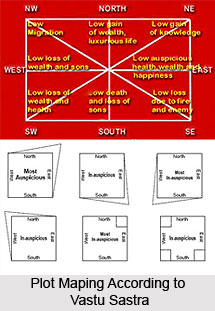 A layout is the most important part of construction. The first step to build an establishment is to prepare a layout of the plot. Before preparing the layout leveling of the entire ground should be done. One mistake can nullify the overall impact of Vastu Shastra. While the ground is being leveled it is better to have a slope towards the East and the North.
A layout is the most important part of construction. The first step to build an establishment is to prepare a layout of the plot. Before preparing the layout leveling of the entire ground should be done. One mistake can nullify the overall impact of Vastu Shastra. While the ground is being leveled it is better to have a slope towards the East and the North.
There are certain tips suggested by the Indian Vastu Shastra to purchase and prepare the layouts for the plots:-
Plots with curved North-East corners should not be purchased. If these are purchased at all the compound wall at North-East corner should be constructed at right angles.
Plots with rounded North-West corners are perfect for constructing rectangular buildings.
If in certain plots the South-East or the South - West corners have been cut off then these can be used for constructing rectangular buildings.
Plots with auspicious Vithishula on the East - North-East, South - South-East, North-North - East and West - North-West are considered favorable. People residing in such plots will surely prosper.
If the Vithishula is on the East - South-East, North-North-West and West - South-West of a plot it is inauspicious. Hence, it is not profitable to purchase these plots.
A Vithishula on the South - South-West is considered very inauspicious. The purchasing of such plots should be completely avoided.
In the plots if there are roads to West, South or North, these can be easily purchased.
On the other hand certain plots have only one road and that is in the North direction then this kind of plots too will prove profitable.
There are plots where there is only one way out, South. Although unfavorable but these plots can be put to use if the gate of the compound is constructed in the South-South East direction.




















